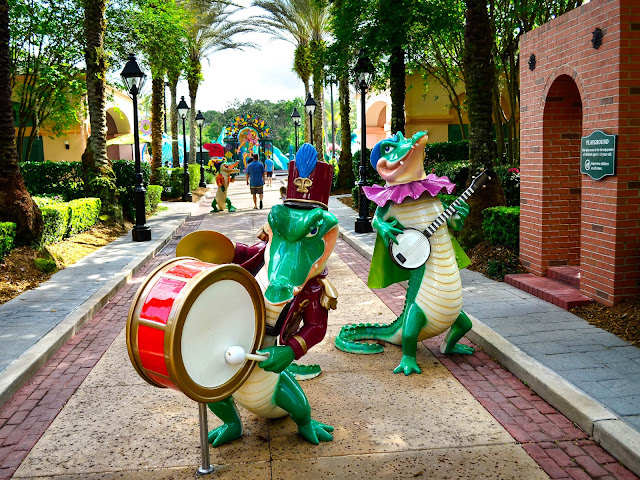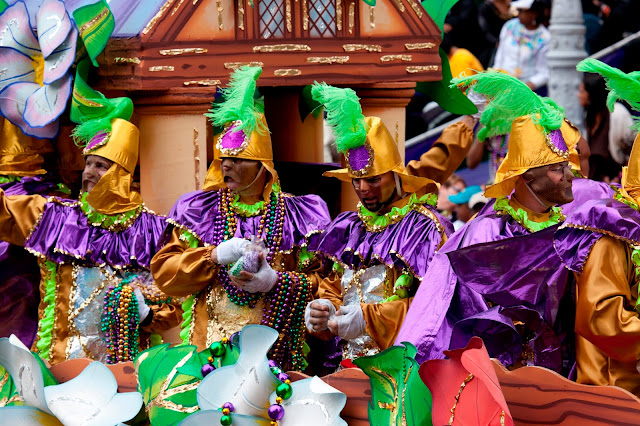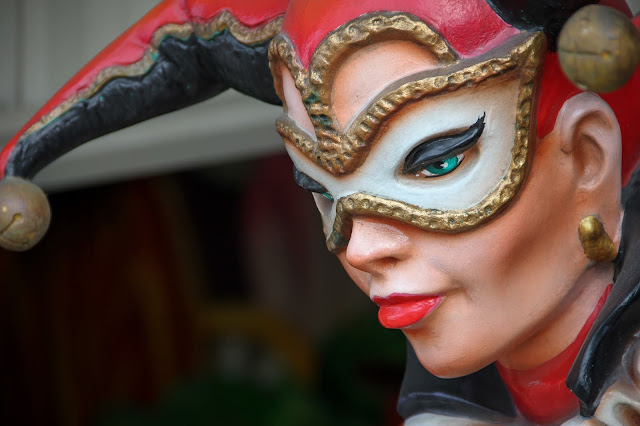When I was a little girl, I became enchanted with Mardi Gras and Carnival. My family went to Disney World and, on one of our days there, we took some time to explore the new hotels, checking out the décors and scenery. When we walked into the Port Orleans French Quarter hotel, we fell in love with the captivating motifs and grand decorations. Colorful, bright faces hung over us in the dining hall as alligators playing instruments stood along the path that led down to an amazing swimming pool, complete with an enormous dragon whose tongue was a slide. The colors, the music, the elaborate ironwork, the whimsical characters – it was all so magical. So much so that my parents switched hotels and we stayed at Port Orleans for the rest of our trip.
 |
| Disney's Port Orleans French Quarter Hotel |
 |
| Disney's Port Orleans French Quarter Hotel |
 |
| Disney's Port Orleans French Quarter Hotel |
 |
| Disney's Port Orleans French Quarter Hotel |
 |
| Disney's Port Orleans French Quarter Hotel |
More than 30 years later, I am still in love with masks, French Quarter style, vintage entertainment, and Mardi Gras. But where did this mesmerizing tradition come from? Is there a deeper meaning aside from just merry making? And why does Venice famously have Carnival masks so similar to New Orleans’ Mardi Gras masks?
 |
 |
| My children in their Mardi Gras masks in 2013. |
What is Mardi Gras?
Mardi Gras is the conclusion of the long Carnival season, which is traditionally from Twelfth Night (January 6th) until Ash Wednesday, the beginning of Lent in Catholicism. (However, note that this celebration is called by other names in different regions and sometimes has different dates.) “Carnival” comes from the Latin carnelevamen meaning “farewell to flesh”. The words “Mardi Gras” comes from the French words for “Fat Tuesday” and it is also called Shrove Tuesday or Shrove Tide in Catholicism. Shrove Tuesday traditionally is the day to go to church and confess all of one’s sins, to prepare for the Lent season of prayer and restraint. Shrove comes from the English word shrive, which means to receive absolutions from sins, in other words, to receive a shrift. After confession, people would spend the rest of the day in merriment and feasting to strengthen their fortitude for the self-denial of Lent. It was called Fat Tuesday because also on this day people would empty their pantries and larders of sugar and other indulgent ingredients just before Lent. In German, Fat Tuesday is called Fast-Nacht (“fast eve”). The Pennsylvania Dutch have a popular confection called a Fastnacht donut, a fluffy donut sometimes covered with sugar and/or filled with cream.
Mardi Gras is the conclusion of the long Carnival season, which is traditionally from Twelfth Night (January 6th) until Ash Wednesday, the beginning of Lent in Catholicism. (However, note that this celebration is called by other names in different regions and sometimes has different dates.) “Carnival” comes from the Latin carnelevamen meaning “farewell to flesh”. The words “Mardi Gras” comes from the French words for “Fat Tuesday” and it is also called Shrove Tuesday or Shrove Tide in Catholicism. Shrove Tuesday traditionally is the day to go to church and confess all of one’s sins, to prepare for the Lent season of prayer and restraint. Shrove comes from the English word shrive, which means to receive absolutions from sins, in other words, to receive a shrift. After confession, people would spend the rest of the day in merriment and feasting to strengthen their fortitude for the self-denial of Lent. It was called Fat Tuesday because also on this day people would empty their pantries and larders of sugar and other indulgent ingredients just before Lent. In German, Fat Tuesday is called Fast-Nacht (“fast eve”). The Pennsylvania Dutch have a popular confection called a Fastnacht donut, a fluffy donut sometimes covered with sugar and/or filled with cream.
 |
| "Merrymakers at Shrovetide" - a painting by Dutch artist Frans Hals, c. 1616. |
 |
| "Shrove Tuesday Along the Dijver in Bruges" - a painting by Belgian artist Victor Lagye (1825-1896) |
Carnival in Europe
Carnival was adopted into Catholicism in the Middle Ages, but the tradition stems back to ancient European pagan festivals such as Bacchanalia, Lupercalia, Saturnalia, and possibly Spurcalia. Bacchanalia was a celebration of the Roman god of wine, Bacchus, but it originated in Greece as Dionysia, as the Greek name for the god of wine was Dionysus. However, it is believed that its origins may have stemmed from older fertility rites. In Greece, Dionysia was a time of great feasting, processions, and theatre. When Bacchanalia first began in Italy, it was a secret party for women only, but eventually it included men as well. In 186 BCE, the Roman Senate outlawed most Bacchanalia celebrations because of their association with orgies, but the festival was kept alive in some areas despite the proclamation.
Lupercalia was celebrated on February 15 and involved a bizarre ritual which began with sacrificing a goat and a dog. The bloody knife was then smeared on two of the participants' foreheads, who would then laugh as wool dipped in milk wiped the blood away. The revelers would then make straps out of the sacrificed animal’s skins and run around whipping any woman they saw. It was believed that being struck by the whip would ensure fertility for the woman.
Saturnalia was a festival in Rome very similar to Kronia in Greece and was a time of great festivities. It was originally observed on December 17, but it was extended to three and then, even later, seven days. It was associated with the winter sowing season. The revelers would choose a “king” to reign during the celebration and slaves were given complete freedom. Craftsmen, called Sigillarrii, would make candles and wax fruit and statuettes which were given as gifts.
It is quite often stated that Spurcalia was a Germanic pagan solar festival that took place in winter that was eventually overtaken by Carnival. However, that theory is not without contention.
 |
| Venetian Carnival masks. Photo by April Downey. This photo is one of the designs on my merchandise site - see link below. |
American Mardi Gras
American Mardi Gras originated in 1702 in Mobile, Alabama. In 1711, the Boeuf Gras Society was founded in Mobile and lasted until 1817. The Boeuf Gras is the “fatted bull” which represents the last meat to be eaten before Lent. This was an important part of the celebration in France since at least 1512, but it is thought it may be derived from Druidic times.
American Mardi Gras originated in 1702 in Mobile, Alabama. In 1711, the Boeuf Gras Society was founded in Mobile and lasted until 1817. The Boeuf Gras is the “fatted bull” which represents the last meat to be eaten before Lent. This was an important part of the celebration in France since at least 1512, but it is thought it may be derived from Druidic times.
By the 1730s it had spread to New Orleans, Louisiana. In the early days though, Mardi Gras celebrations were mostly un-organized. That is until 1857, when a mysterious secret society sprang up in New Orleans, which magnified the celebration in scope and grandeur – the Mystick Krewe of Comus. (Comus being the Greek god of festivities.) At around 9pm on Mardi Gras evening, the merry band of revelers dressed up as characters from mythology and demons and paraded through the street. They displayed fascinating tableaus (stationary figures representing a historical scene). After the grand public display, certain people were fortuitously invited to a ball at the Gaiety Theatre. The event was a huge success and what followed was a yearly extravagance of mirth and merry. The years of 1862 through 1865 saw a break in the festival as New Orleans was in grip of the Civil War. However, in 1866 the Mystick Krewe once again took to the streets and reinstated their yearly display, one that would capture the interest of the entire nation. By 1870, visitors would come from all over to see the show. Other Mardi Gras organizations sprang up, such as the Krewe of Momus and Krewe of Proteus. Aside from select times of absence (due to war, epidemics, etc.), the Mystick Krewe of Comus ran their parade every year up until 1991; however, they still host a Mardi Gras ball.
 |
| A turn-of-the-century float in New Orleans. |
In 1872, a new tradition was added by the city of New Orleans – the arrival of the King of Carnival! An organization named the Rex Organization was founded (with “rex” being the Latin word for “king”). Where the Mystick Krewe of Comus ruled the night, Rex ruled the day. The sporadic day time processions were starting to be replaced with a bit more organized procession, featuring the King of Carnival, around whom a mythology was composed. It was said that he was the son of Old King Cole and the Greek muse Terpsichore and he was hundreds of years old. The first person chosen to be the Rex of Carnival was Lewis J. Solomon. Along with this new event, symbols and traditions were established that we forever since associate with Mardi Gras. The colors purple, gold, and green were picked as the official colors. An anthem was chosen - “If Ever I Cease to Love”, from the musical comedy “Blue Beard”. In 1872, this song was very popular among the bands because of a rumor that was circulating about Russian Grand Duke Alexis Romanoff. It was said that while visiting St. Louis he fell in love with a performer named Lydia Thompson while she was singing this song. The Grand Duke made his arrival in New Orleans in time for Mardi Gras and all the bands played this song, alluding to the rumor. Ever since then, the song has been linked with New Orleans and Mardi Gras.
 |
| The Rex Organization's King of Carnival edict from 1924. |
The first Rex parade was fairly modest. The King rode a horse and many of the maskers in the procession were those people already on the streets. The following year in 1873, the parade became more organized and grand. A Carnival Queen was chosen to rule alongside the King as well. The King would send “edicts” across the country, inviting visitors to New Orleans for his festival. Eventually the Rex Organization was incorporated as the School of Design. Like the Mystick Krewe, they too would add a ball to their program. Every year Rex produces a pageant with a different theme, but they do have a couple of floats that return every year; one of these is the Boeuf Gras. Originally, the Boeuf Gras was a live bull in the parade, but this tradition stopped in 1901. In 1959, the Boeuf Gras returned only in the form of a paper-mache float.
 |
| Mardi Gras parade in New Orleans. |
 |
| Mardi Gras parade in New Orleans. |
The Rex Organization’s motto is Pro Bono Publico, which means “for the public good”. This motto would be kept to with great generosity during the aftermath of Hurricane Katrina, when Rex started up three programs to help the city and its residents during the crisis.
Today, 149 years later, Rex and their fantastic displays are an integral part of Mardi Gras in New Orleans.
Today, 149 years later, Rex and their fantastic displays are an integral part of Mardi Gras in New Orleans.
Modern Mardi Gras
Today, many people join in Mardi Gras festivities, whether Catholic or not and with the observance of Lent being unnecessary for participation. The pagan ritual sacrifices are all but memory. It is an amazing thing for such a festival to have survived over 2,000 years, yet it does represent a primal truth we all must face – the long cold winter of deficiency (whether imposed by Fortune or oneself) will come to everyone at some point, but until then, why not have a little fun?
To purchase vibrant Carnival themed apparel and gifts, please click here
To learn about a lesser-known Catholic holiday, please click here
 |
| Carnival parade in Brazil. |
A Carnival performer in Brazil.
 |
| Mardi Gras parade in New Orleans. |
 |
| A Mardi Gras joker decoration. |
 |
| Mardi Gras parade in New Orleans. |
 |
| Mardi Gras parade in New Orleans. |
 |
| Mardi Gras parade in New Orleans. |
 |
| A Mardi Gras Krewe Captain. |
 |
| Coco-Cola float in a 1915 Mardi Gras parade in Florida. |
 |
| A Venetian mask. |
 |
| "Elise et Marguerite" - a photograph by Wilb. Nestler of children celebrating Mardi Gras in Brussels, Belgium. |
 |
| Mardi Gras parade in New Orleans. |
REFERENCES:
Abxbay. “Carnival venice 2015 135.” Link
Ann, Jackie. “The History Behind New Orleans’ Oldest Mardi Gras Krewe Will Fascinate You.” Only In Your State. January 11, 2019. Link
“Carnival.” The Encyclopedia Britannica. Link
Galyonkin, Sergey. “Mardi Gras 2020, New Orleans, Louisiana – Float Figure.” Link
Gzzz. “Carnival of Basel’s Waggis 2018 (1).” Link
Hardy, Arthur. “Rex’s ‘Boeuf Gras’ Linke Carnival to Ancient Celebration.” NOLA.com February 27, 2017. Link
Lautenbacher, Marc. “Fastnachtsumzug, Rottweil, Suddeutschland.” Link
Madden, John W. Hand Book of The Carnival: Containing Its Ancient and Modern Observance; History of the Mystick Krewe of Comus, The Twelfth Night Revelers, and Knights of Momus, with Annals of the Reign of His Majesty, The King of the Carnival in New Orleans. New Orleans, LA: Kain & Co., 1874.
Rex. Link
Scênes du carnaval / Ed. Swebach del. , None. [Paris: chez engelmann & cie., cite bergère no. 1, between 1820 and 1850] Photograph. Link
Ristuccia, Nathen J. “The Rise of Spurcalia: Medieval Festival and Modern Myth.” Comitatus: Vol. 44, 2013. Link
Sheppard, Geof. “Weston Carnival 209 Westonzoyland CC Carnival.” Link
Tricentennial Music Moment: If Ever I Cease to Love: Link
Prefeitura de Olinda. “Olinda Carnival – Olinda, Pernambuco, Brazil.” Link
Abxbay. “Carnival venice 2015 135.” Link
Ann, Jackie. “The History Behind New Orleans’ Oldest Mardi Gras Krewe Will Fascinate You.” Only In Your State. January 11, 2019. Link
“Carnival.” The Encyclopedia Britannica. Link
Galyonkin, Sergey. “Mardi Gras 2020, New Orleans, Louisiana – Float Figure.” Link
Gzzz. “Carnival of Basel’s Waggis 2018 (1).” Link
Hardy, Arthur. “Rex’s ‘Boeuf Gras’ Linke Carnival to Ancient Celebration.” NOLA.com February 27, 2017. Link
Lautenbacher, Marc. “Fastnachtsumzug, Rottweil, Suddeutschland.” Link
Madden, John W. Hand Book of The Carnival: Containing Its Ancient and Modern Observance; History of the Mystick Krewe of Comus, The Twelfth Night Revelers, and Knights of Momus, with Annals of the Reign of His Majesty, The King of the Carnival in New Orleans. New Orleans, LA: Kain & Co., 1874.
Rex. Link
Scênes du carnaval / Ed. Swebach del. , None. [Paris: chez engelmann & cie., cite bergère no. 1, between 1820 and 1850] Photograph. Link
Ristuccia, Nathen J. “The Rise of Spurcalia: Medieval Festival and Modern Myth.” Comitatus: Vol. 44, 2013. Link
Sheppard, Geof. “Weston Carnival 209 Westonzoyland CC Carnival.” Link
Tricentennial Music Moment: If Ever I Cease to Love: Link
Prefeitura de Olinda. “Olinda Carnival – Olinda, Pernambuco, Brazil.” Link









Great read !
ReplyDelete